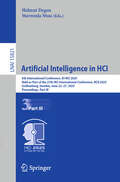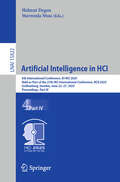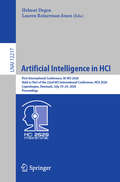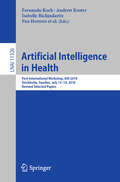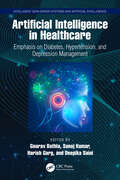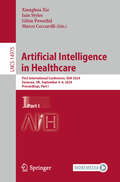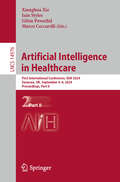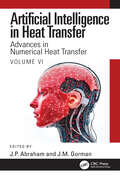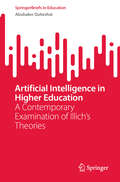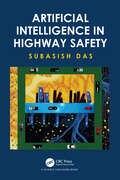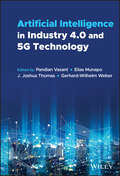- Table View
- List View
Artificial Intelligence in HCI: 6th International Conference, AI-HCI 2025, Held as Part of the 27th HCI International Conference, HCII 2025, Gothenburg, Sweden, June 22–27, 2025, Proceedings, Part III (Lecture Notes in Computer Science #15821)
by Helmut Degen Stavroula NtoaThe four-volume set LNAI 15819–15822 constitutes the thoroughly refereed proceedings of the 6th International Conference on Artificial Intelligence in HCI, AI-HCI 2025, held as part of the 27th International Conference, HCI International 2025, which took place in Gothenburg, Sweden, June 22-17, 2025. The total of 1430 papers and 355 posters included in the HCII 2025 proceedings was carefully reviewed and selected from 7972 submissions. The papers have been organized in topical sections as follows: Part I: Trust and Explainability in Human-AI Interaction; User Perceptions, Acceptance, and Engagement with AI; UX and Socio-Technical Considerations in AI Part II: Bias Mitigation and Ethics in AI Systems; Human-AI Collaboration and Teaming; Chatbots and AI-Driven Conversational Agents; AI in Language Processing and Communication. Part III: Generative AI in HCI; Human-LLM Interactions and UX Considerations; Everyday AI: Enhancing Culture, Well-Being, and Urban Living. Part IV: AI-Driven Creativity: Applications and Challenges; AI in Industry, Automation, and Robotics; Human-Centered AI and Machine Learning Technologies.
Artificial Intelligence in HCI: 6th International Conference, AI-HCI 2025, Held as Part of the 27th HCI International Conference, HCII 2025, Gothenburg, Sweden, June 22–27, 2025, Proceedings, Part IV (Lecture Notes in Computer Science #15822)
by Helmut Degen Stavroula NtoaThe four-volume set LNAI 15819–15822 constitutes the thoroughly refereed proceedings of the 6th International Conference on Artificial Intelligence in HCI, AI-HCI 2025, held as part of the 27th International Conference, HCI International 2025, which took place in Gothenburg, Sweden, June 22-17, 2025. The total of 1430 papers and 355 posters included in the HCII 2025 proceedings was carefully reviewed and selected from 7972 submissions. The papers have been organized in topical sections as follows: Part I: Trust and Explainability in Human-AI Interaction; User Perceptions, Acceptance, and Engagement with AI; UX and Socio-Technical Considerations in AI Part II: Bias Mitigation and Ethics in AI Systems; Human-AI Collaboration and Teaming; Chatbots and AI-Driven Conversational Agents; AI in Language Processing and Communication. Part III: Generative AI in HCI; Human-LLM Interactions and UX Considerations; Everyday AI: Enhancing Culture, Well-Being, and Urban Living. Part IV: AI-Driven Creativity: Applications and Challenges; AI in Industry, Automation, and Robotics; Human-Centered AI and Machine Learning Technologies.
Artificial Intelligence in HCI: First International Conference, AI-HCI 2020, Held as Part of the 22nd HCI International Conference, HCII 2020, Copenhagen, Denmark, July 19–24, 2020, Proceedings (Lecture Notes in Computer Science #12217)
by Lauren Reinerman-Jones Helmut DegenThis book constitutes the refereed proceedings of the First International Conference on Artificial Intelligence in HCI, AI-HCI 2020, held as part of the 22nd International Conference on Human-Computer Interaction, HCII 2020, in July 2020. The conference was planned to be held in Copenhagen, Denmark, but had to change to a virtual conference mode due to the COVID-19 pandemic. The conference presents results from academic and industrial research, as well as industrial experiences, on the use of Artificial Intelligence technologies to enhance Human-Computer Interaction. From a total of 6326 submissions, a total of 1439 papers and 238 posters has been accepted for publication in the HCII 2020 proceedings. The 30 papers presented in this volume were organized in topical sections as follows: Human-Centered AI; and AI Applications in HCI.pical sections as follows: Human-Centered AI; and AI Applications in HCI.
Artificial Intelligence in HCI: Second International Conference, AI-HCI 2021, Held as Part of the 23rd HCI International Conference, HCII 2021, Virtual Event, July 24–29, 2021, Proceedings (Lecture Notes in Computer Science #12797)
by Helmut Degen Stavroula NtoaThis book constitutes the refereed proceedings of the Second International Conference on Artificial Intelligence in HCI, AI-HCI 2021, which was held as part of HCI International 2021 and took place virtually during July 24-29, 2021.The total of 1276 papers and 241 posters included in the 39 HCII 2021 proceedings volumes was carefully reviewed and selected from 5222 submissions. The papers included in this volume were organized in topical sections as follows: Ethics, trust and explainability; human-centered AI; AI applications in HCI; and AI applications in smart environments.
Artificial Intelligence in Health
by Marianne SarazinUndeniable, inescapable, exhilarating and breaking free from the exclusive domain of science, artificial intelligence has become our main preoccupation. A major generator of new mathematical thinking, AI is the result of easy access to information and data, as facilitated by computer technology. Big Data has come to be seen as an unlimited source of knowledge, the use of which is still being fully explored, but its industrialization has swiftly followed in the footsteps of mathematicians; today's tools are increasingly designed to replace human beings, which comes with social and philosophical consequences. Drawing on examples of scientific work and the insights of experts, this book offers food for thought on the consequences and future of AI technology in education, health, the workplace and aging.
Artificial Intelligence in Health Care: The Hope, the Hype, the Promise, the Peril
by The Learning Health System Series National Academy of MedicineThe emergence of artificial intelligence (AI) in health care offers unprecedented opportunities to improve patient and clinical team outcomes, reduce costs, and impact population health. While there have been a number of promising examples of AI applications in health care, it is imperative to proceed with caution or risk the potential of user disillusionment, another AI winter, or further exacerbation of existing health- and technology-driven disparities. This Special Publication synthesizes current knowledge to offer a reference document for relevant health care stakeholders. It outlines the current and near-term AI solutions; highlights the challenges, limitations, and best practices for AI development, adoption, and maintenance; offers an overview of the legal and regulatory landscape for AI tools designed for health care application; prioritizes the need for equity, inclusion, and a human rights lens for this work; and outlines key considerations for moving forward. AI is poised to make transformative and disruptive advances in health care, but it is prudent to balance the need for thoughtful, inclusive health care AI that plans for and actively manages and reduces potential unintended consequences, while not yielding to marketing hype and profit motives.
Artificial Intelligence in Health Professions Education: Proceedings Of A Workshop
by Board on Global Health Global Forum on Innovation in Health Professional Education National Academies of Sciences, Engineering, and Medicine Health and Medicine DivisionThe National Academies Global Forum on Innovation in Health Professional Education hosted a multi-day workshop series in March and April 2023 to explore the potential of artificial intelligence (AI) in health professions education. Speakers at the workshops provided background on AI; discussed the social, cultural, policy, legal, and regulatory considerations to integrating AI into health care and training; considered the skills health professionals will need as educators and providers to effectively use AI in practice; and explored needs for educating the next generation of health workers. Speakers took consideration of the bias, burden, health equity concerns that introducing AI into clinical education would bring. This Proceedings of a Workshop summarizes the discussions held during the workshop.
Artificial Intelligence in Health: First International Workshop, AIH 2018, Stockholm, Sweden, July 13-14, 2018, Revised Selected Papers (Lecture Notes in Computer Science #11326)
by Michael Schumacher Nirmalie Wiratunga David Riaño Richard Lenz Manfred Reichert Annette Ten Teije Fernando Koch Christian Guttmann Andrew Koster Stefania Montani Pau Herrero Sara Montagna Isabelle Bichindaritz Beatriz López Cindy Marling Clare MartinThis book constitutes the refereed post-conference proceedings of the First International Workshop on Artificial Intelligence in Health, AIH 2018, in Stockholm, Sweden, in July 2018. This workshop consolidated the workshops CARE, KRH4C and AI4HC into a single event.The 18 revised full papers included in this volume were carefully selected from the 26 papers accepted for presentation out of 42 initial submissions. The papers present AI technologies with medical applications and are organized in three tracks: agents in healthcare; data science and decision systems in medicine; and knowledge management in healthcare.
Artificial Intelligence in Healthcare (Advanced Technologies and Societal Change)
by Tarun K. Sharma Chitresh Banerjee Lalit Garg Sebastian BasterrechThis book highlights the analytics and optimization issues in healthcare systems, proposes new approaches, and presents applications of innovative approaches in real facilities. In the past few decades, there has been an exponential rise in the application of swarm intelligence techniques for solving complex and intricate problems arising in healthcare. The versatility of these techniques has made them a favorite among scientists and researchers working in diverse areas. The primary objective of this book is to bring forward thorough, in-depth, and well-focused developments of hybrid variants of swarm intelligence algorithms and their applications in healthcare systems.
Artificial Intelligence in Healthcare Industry (Advanced Technologies and Societal Change)
by Jyotismita Talukdar Thipendra P. Singh Basanta BarmanThis book presents a systematic evolution of artificial intelligence (AI), its applications, challenges and solutions in the field of healthcare. The book mainly covers the foundations and various methods of learning in artificial intelligence with its application in healthcare industry. This book provides a comprehensive introduction to data analysis using AI as a tool in the generation, normalization and analysis of healthcare data in association with several evaluation techniques and accuracy measurements. The book is divided into three major sections describing the basic foundations of AI and its associated algorithms, history of artificial intelligence in healthcare, recent developments and several modeling techniques for the same. The last section of the book provides insights into several implementations and methods of evaluation and accuracy prediction for healthcare analysis in AI. Extensive use of data for analysis and prediction using several technologies has transformed the lives of normal people indirectly effecting our process to communicate, learn, work and socialize within the society. Thus, the book also provides an insight into the ethics of AI that is very vital in the process of implementation and evaluation of healthcare data. The book provides an organized analysis to a considerable part of data in a digitized society. In view of this, it covers the theory, methodology, perfection and verification of empirical work for health-related data processing. Particular attention is devoted to in-depth experiments and applications.
Artificial Intelligence in Healthcare Information Systems—Security and Privacy Challenges (Information Systems Engineering and Management #34)
by Narasimha Rao Vajjhala Edlira Martiri Fisnik Dalipi Bian Yang“Artificial Intelligence (AI) in Healthcare Information Systems: Security and Privacy Challenges” offers a deep dive into the integration of AI in healthcare, with a primary focus on addressing the significant security and privacy concerns that arise in this domain. The chapters in this book highlight the transformative potential of AI in diagnosing and predicting diseases, as well as its impact on fields like fetal medicine, but places special emphasis on the need for robust encryption, data protection techniques, and ethical considerations to safeguard sensitive healthcare data. The book also explores global case studies, from India to Kazakhstan, outlining the challenges and prospects of AI adoption in diverse healthcare settings. Readers will gain insights into AI's role in improving patient outcomes while navigating the complexities of data privacy and security. The book is a valuable resource for healthcare professionals, technologists, and policymakers who are focused on implementing AI-driven solutions securely and ethically in healthcare systems.
Artificial Intelligence in Healthcare and Medicine
by Kayvan NajarianThis book provides a comprehensive overview of the recent developments in clinical decision support systems, precision health, and data science in medicine. The book targets clinical researchers and computational scientists seeking to understand the recent advances of artificial intelligence (AI) in health and medicine. Since AI and its applications are believed to have the potential to revolutionize healthcare and medicine, there is a clear need to explore and investigate the state-of-the-art advancements in the field. This book provides a detailed description of the advancements, challenges, and opportunities of using AI in medical and health applications. Over 10 case studies are included in the book that cover topics related to biomedical image processing, machine learning for healthcare, clinical decision support systems, visualization of high dimensional data, data security and privacy, bioinformatics, and biometrics. The book is intended for clinical researchers and computational scientists seeking to understand the recent advances of AI in health and medicine. Many universities may use the book as a secondary training text. Companies in the healthcare sector can greatly benefit from the case studies covered in the book. Moreover, this book also: Provides an overview of the recent developments in clinical decision support systems, precision health, and data science in medicine Examines the advancements, challenges, and opportunities of using AI in medical and health applications Includes 10 cases for practical application and reference Kayvan Najarian is a Professor in the Department of Computational Medicine and Bioinformatics, Department of Electrical Engineering and Computer Science, and Department of Emergency Medicine at the University of Michigan, Ann Arbor. Delaram Kahrobaei is the University Dean for Research at City University of New York (CUNY), a Professor of Computer Science and Mathematics, Queens College CUNY, and the former Chair of Cyber Security, University of York. Enrique Domínguez is a professor in the Department of Computer Science at the University of Malaga and a member of the Biomedical Research Institute of Malaga. Reza Soroushmehr is a Research Assistant Professor in the Department of Computational Medicine and Bioinformatics and a member of the Michigan Center for Integrative Research in Critical Care, University of Michigan, Ann Arbor.
Artificial Intelligence in Healthcare: Emphasis on Diabetes, Hypertension, and Depression Management (Intelligent Data-Driven Systems and Artificial Intelligence)
by Harish Garg Deepika Saini Gourav Bathla Sanoj KumarThis book presents state-of-the-art research works for a better understanding of the advantages and limitations of AI techniques in the field of healthcare. It will further discuss artificial intelligence applications in depression, hypertension and diabetes management. The text also presents an artificial intelligence chatbot for depression, diabetes, and hypertension self-help.This book: Provides a structured overview of recent developments of artificial intelligence applications in the healthcare sector. Presents an in-depth understanding of how artificial intelligence techniques can be applied to diabetes management. Showcases supervised learning techniques based on datasets for depression management. Discusses artificial intelligence chatbot for diabetes, depression, and hypertension self-care. Highlights the importance of artificial intelligence in managing and predicting diabetes, hypertension, and depression. The text is primarily written for senior undergraduate, graduate students, and academic researchers in diverse fields including electrical engineering, electronics and communications engineering, computer science and engineering, and biomedical engineering.
Artificial Intelligence in Healthcare: First International Conference, AIiH 2024, Swansea, UK, September 4–6, 2024, Proceedings, Part I (Lecture Notes in Computer Science #14975)
by Marco Ceccarelli Xianghua Xie Iain Styles Gibin PowathilThe two-volume set LNCS 14975 + 14976 constitutes the proceedings of the First International Conference on Artificial Intelligence in Healthcare, AIiH 2024, which took place in Swansea, UK, in September 2024. The 47 full papers included in the proceedings were carefully reviewed and selected from 70 submissions. They were organized in the following topical sections: Part I: Personalised Healthcare and Medicine; AI driven early diagnosis and prevention; AI driven robotics for healthcare; AI in mental health; Part II: AI in proactive care and intervention; AI-aided medical imaging and analysis; Medical signal and image processing; Assisted living technology; Digital twinning, virtual pathology and oncology; Patient data, privacy and ethics.
Artificial Intelligence in Healthcare: First International Conference, AIiH 2024, Swansea, UK, September 4–6, 2024, Proceedings, Part II (Lecture Notes in Computer Science #14976)
by Marco Ceccarelli Xianghua Xie Iain Styles Gibin PowathilThe two-volume set LNCS 14975 + 14976 constitutes the proceedings of the First International Conference on Artificial Intelligence in Healthcare, AIiH 2024, which took place in Swansea, UK, in September 2024. The 47 full papers included in the proceedings were carefully reviewed and selected from 70 submissions. They were organized in the following topical sections: Part I: Personalised Healthcare and Medicine; AI driven early diagnosis and prevention; AI driven robotics for healthcare; AI in mental health; Part II: AI in proactive care and intervention; AI-aided medical imaging and analysis; Medical signal and image processing; Assisted living technology; Digital twinning, virtual pathology and oncology; Patient data, privacy and ethics.
Artificial Intelligence in Healthcare: Recent Applications and Developments (Brain Informatics and Health)
by Jenny Carter Mufti Mahmud Arjab Singh Khuman Tianhua ChenRecent advances in artificial intelligence (AI) and machine learning have witnessed many successes in various disciplines including the healthcare sector. Innovations in intelligent medical systems have revolutionized the way in which healthcare services are provided, ranging from making clinical diagnosis, developing personalized treatment and drugs, assisting patient monitoring, to automating administrative tasks and reducing operational costs. In this book, the authors present key applications in the general area of health care, where AI has made significant successes. From the individual chapters, the readers will be provided with a range of examples to illustrate the wide plethora of application domains utilizing state-of-the-art AI techniques, proving credence to the versatility and effectiveness of an AI approach in health care and medicine. We envisage that this book is ideal for individuals new to the notion of AI in health care, equally, early career academics who wish to further expand on their knowledge in AI in medicine. What will be presented is in no means an exhaustive list of applications, but most definitely a varied one.
Artificial Intelligence in Heat Transfer: Advances in Numerical Heat Transfer Volume VI
by J. M. Gorman J. P. AbrahamArtificial Intelligence in Heat Transfer shows how artificial intelligence (AI) tools and techniques, such as artificial neural networks, machine learning algorithms, genetic algorithms, etc., provide practical benefits specific to thermal sciences. It presents case studies involving heat and mass transfer, multi-objective optimization, conjugate heat transfer, nanofluids, thermal radiation, heat transfer through porous media (metal foam), and more.Drawing on the collective expertise of leading researchers and experts in multiple fields, the book provides an in-depth understanding of the possibilities that emerge when these tools are applied to problems related to thermal sciences. AI is an ever-evolving discipline that has created new and groundbreaking opportunities to advance the mechanical engineering field, particularly in the area of numerical heat transfer. This volume, Advances in Numerical Heat Transfer, explores various ways AI is used in heat transfer to solve engineering problems.This book will serve as an important resource for upper-level undergraduate students, researchers, engineers, and professionals, equipping them with the knowledge and inspiration to push the boundaries of the thermal sciences through AI-driven tools and techniques.
Artificial Intelligence in Higher Education and Scientific Research: Future Development (Bridging Human and Machine: Future Education with Intelligence)
by Fatima RoumateThis book explains the interaction between artificial intelligence and higher education. It explores artificial intelligence’s tangible and intangible impact on higher education and scientific research and discusses how higher education and scientific research enhance the progress of artificial intelligence technologies. Based on systematic analysis with a multidisciplinary approach and a combination of theory and practice, the book brings original perspectives from the massive use of artificial intelligence in higher education and scientific research since the appearance of COVID-19. This book also discusses ethics in artificial intelligence, taking into consideration the recommendation on ethics of artificial intelligence adopted by UNESCO. This book explains the importance of technological sovereignty and new strategies to face current and future challenges related to e-learning, deep learning, and machine learning.
Artificial Intelligence in Higher Education: A Contemporary Examination of Illich's Theories (SpringerBriefs in Education)
by Abubaker QutieshatThis book is multi-dimensional exploration of Ivan Illich's critique of institutionalized education. It dissects, analyzes, and understands the implications of his critique for the future of education in a world increasingly influenced by technology, particularly artificial intelligence (AI). The book outlines the problems with current educational systems and discusses potential alternatives, considering the role of modern technology like AI. It employs a multi-disciplinary approach, incorporating historical analysis, philosophical inquiry, and practical considerations to explore Illich's critique. Readers will be equipped with the knowledge to critically assess the educational landscape and consider viable alternatives for reform. This book contributes to the field of educational theory and practice in its nuanced understanding of Illich's critique and its implications for educational reform. It serves as both a theoretical exploration and a practical guide, making it a valuable resource for a wide range of readers, including educators, policymakers, students, and anyone interested in the future of education.
Artificial Intelligence in Higher Education: A Practical Approach
by Mohamed Elhoseny Amina Omrane Prathamesh Churi Shubham JoshiThe global adoption of technology in education is transforming the way we teach and learn. Artificial Intelligence is one of the disruptive techniques to customize the experience of different learning groups, teachers, and tutors. This book offers knowledge in intelligent teaching/learning systems, and advances in e-learning and assessment systems.
Artificial Intelligence in Highway Safety
by Subasish DasArtificial Intelligence in Highway Safety provides cutting-edge advances in highway safety using AI. The author is a highway safety expert. He pursues highway safety within its contexts, while drawing attention to the predictive powers of AI techniques in solving complex problems for safety improvement. This book provides both theoretical and practical aspects of highway safety. Each chapter contains theory and its contexts in plain language with several real-life examples. It is suitable for anyone interested in highway safety and AI and it provides an illuminating and accessible introduction to this fast-growing research trend. Material supplementing the book can be found at https://github.com/subasish/AI_in_HighwaySafety. It offers a variety of supplemental materials, including data sets and R codes.
Artificial Intelligence in Industrial Applications: Approaches to Solve the Intrinsic Industrial Optimization Problems (Learning and Analytics in Intelligent Systems #25)
by Tarun K. Sharma Steven Lawrence FernandesThis book highlights the analytics and optimization issues in industry, to propose new approaches, and to present applications of innovative approaches in real facilities. In the past few decades there has been an exponential rise in the application of artificial intelligence for solving complex and intricate problems arising in industrial domain. The versatility of these techniques have made them a favorite among scientists and researchers working in diverse areas. The book is edited to serve a broad readership, including computer scientists, medical professionals, and mathematicians interested in studying computational intelligence and their applications. It will also be helpful for researchers, graduate and undergraduate students with an interest in the fields of Artificial Intelligence and Industrial problems. This book will be a useful resource for researchers, academicians as well as professionals interested in the highly interdisciplinary field of Artificial Intelligence.
Artificial Intelligence in Industry 4.0 and 5G Technology
by Pandian Vasant Gerhard-Wilhelm Weber Elias Munapo J. Joshua ThomasArtificial Intelligence in Industry 4.0 and 5G Technology Explores innovative and value-added solutions for application problems in the commercial, business, and industry sectors As the pace of Artificial Intelligence (AI) technology innovation continues to accelerate, identifying the appropriate AI capabilities to embed in key decision processes has never been more critical to establishing competitive advantage. New and emerging analytics tools and technologies can be configured to optimize business value, change how an organization gains insights, and significantly improve the decision-making process across the enterprise. Artificial Intelligence in Industry 4.0 and 5G Technology helps readers solve real-world technological engineering optimization problems using evolutionary and swarm intelligence, mathematical programming, multi-objective optimization, and other cutting-edge intelligent optimization methods. Contributions from leading experts in the field present original research on both the theoretical and practical aspects of implementing new AI techniques in a variety of sectors, including Big Data analytics, smart manufacturing, renewable energy, smart cities, robotics, and the Internet of Things (IoT). Presents detailed information on meta-heuristic applications with a focus on technology and engineering sectors such as smart manufacturing, smart production, innovative cities, and 5G networks. Offers insights into the use of metaheuristic strategies to solve optimization problems in business, economics, finance, and industry where uncertainty is a factor. Provides guidance on implementing metaheuristics in different applications and hybrid technological systems. Describes various AI approaches utilizing hybrid meta-heuristics optimization algorithms, including meta-search engines for innovative research and hyper-heuristics algorithms for performance measurement. Artificial Intelligence in Industry 4.0 and 5G Technology is a valuable resource for IT specialists, industry professionals, managers and executives, researchers, scientists, engineers, and advanced students an up-to-date reference to innovative computing, uncertainty management, and optimization approaches.
Artificial Intelligence in Industry 4.0: A Collection of Innovative Research Case-studies that are Reworking the Way We Look at Industry 4.0 Thanks to Artificial Intelligence (Studies in Computational Intelligence #928)
by Christina Klüver Alexiei Dingli Foaad HaddodThis book is intended to help management and other interested parties such as engineers, to understand the state of the art when it comes to the intersection between AI and Industry 4.0 and get them to realise the huge possibilities which can be unleashed by the intersection of these two fields. We have heard a lot about Industry 4.0, but most of the time, it focuses mainly on automation. In this book, the authors are going a step further by exploring advanced applications of Artificial Intelligence (AI) techniques, ranging from the use of deep learning algorithms in order to make predictions, up to an implementation of a full-blown Digital Triplet system. The scope of the book is to showcase what is currently brewing in the labs with the hope of migrating these technologies towards the factory floors. Chairpersons and CEOs must read these papers if they want to stay at the forefront of the game, ahead of their competition, while also saving huge sums of money in the process.
Artificial Intelligence in Information and Communication Technologies, Healthcare and Education: A Roadmap Ahead
by Parikshit N. Mahalle Yogesh H. Dandawate Rajendra S. Talware Ganesh C. Patil Sachin R. Sakhare Pravin R. FutaneArtificial Intelligence in Information and Communication Technologies, Healthcare and Education: A Roadmap Ahead is designed as a reference text and discusses inter-dependability, communication and effective control for the betterment of services through artificial intelligence (AI), as well as the challenges and path ahead for AI in computing and control across different domains of business and human life. The book accommodates technologies and application domains including backbone hardware, systems and methods for deployment, which help incorporating intelligence through different supervised and probabilistic learning approaches. Features The book attempts to establish a connection between hardware, software technologies and algorithmic intelligence for data analysis and decision support in domains such as healthcare, education and other aspects of business and mobility. It presents various recent applications of artificial intelligence in information and communication technologies such as search and optimization methods, machine learning, data representation and ontologies, and multi-agent systems. The book provides a collection of different case studies with experimentation results than mere theoretical and generalized approaches. Covers most of the applications using the trending technologies like machine learning (ML), data science (DS), Internet of Things (IoT), and underlying information and communication technologies. The book is aimed primarily at advanced undergraduates and postgraduate students studying computer science, computer applications, and information technology. Researchers and professionals will also find this book useful.
